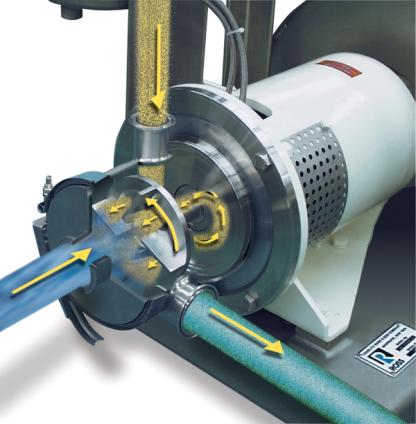Tech Report
Use of powder induction mixing technology can significantly reduce raw material costs.

Technology Brief
An efficient mixing system with powder induction capability enables manufacturers to optimize raw material costs in two ways: by allowing them to source and handle ingredients in dry form rather than the more expensive liquid form; and by maximizing yield of all powder components.
Sourcing raw materials in liquid vs. powder form
Many manufacturers source raw materials in liquid form mainly for convenience. Compared to powders, liquids are easier to handle and mix with other ingredients. For example, within the paper industry, chemicals are commonly shipped in roughly 50% concentrated form. Water is then added to achieve a <=10% solution that is required for process needs or finished product.
Significant savings may be obtained if raw materials are ordered in powder form instead of liquid form. Huge amounts can be saved in shipping costs alone, especially with large volume requirements of slurries or solutions that are mainly water in composition. The key is to have an efficient and repeatable in-house mixing process for dispersing solids into liquid.
Powder induction mixing technology
Depending on the solids involved, manufacturers face one or more mixing challenges such as formation of agglomerates or lumps, floating powders, dusting and long cycle time. A mixing system equipped for powder induction simplifies material handling and resolves the above mentioned issues. The Solids/Liquid Injection Manifold (SLIM) available on Ross High Shear Mixers offers this functionality. In a SLIM mixer, a ported rotor and stator specially designed to generate a powerful vacuum draws powders directly into the high shear zone within the mix chamber, where they are instantly dispersed into the liquid.
Fast, reliable mixing
Operation of a SLIM system is simple and straightforward - just turn on the mixer and start inducting powders. Because solids and liquids are combined and mixed simultaneously, the formation of agglomerates is prevented. The sub-surface addition of solids also eliminates the problem of floating powders.
Reduce waste and extend the value of your raw materials
With conventional mixing systems, it is quite common for operators to contend with either a long cycle time or less than ideal product quality due to inadequate mixing. In the extreme cases, powders are intentionally overdosed and the undispersed agglomerates are simply filtered out.
By preventing the formation agglomerates, lumps or "fish eyes" in the first place, one ensures maximum yield of the solid components. Revealing their full functionality through efficient mixing lowers raw material costs, eliminates downstream filtering or rework operations, and produces high quality finished product in a consistent manner.
As businesses become more and more competitive, re-examining raw material costs and establishing a stable mixing process will help increase both profit margin and processing flexibility.
How the SLIM technology works

The above illustration shows how an inline SLIM mixer works. The liquid stream (1) enters the mixer and immediately encounters the powder addition. Drawn into the mixer by a powerful vacuum, the powder (2) is injected through the ported rotor directly into the high shear zone. The resulting dispersion (3) is expelled centrifugally through the stator openings at high velocity.
Sample Application: Clay Dispersion

A manufacturer of specialty chemicals was sourcing their kaolin clay slurry from an out-of-state supplier. Having to transport the slurry which consists of about 40% water by weight was not economical so they considered preparing the slurry themselves. During initial testing, they used an existing kettle with propeller mixer which they had in-house. The process took several hours to finish and dusting was a major concern.
A visit to the Ross Test & Development Center confirmed that this was a fitting application for the SLIM. In less than 10 minutes, around 40 lbs of kaolin clay powders were inducted into a sodium silicate-water solution via a SLIM hopper attachment. In the transfer of clay powders into the SLIM hopper, a very negligible amount of airborne solids was generated.
A batch SLIM installation: Powders are loaded into the hopper and as soon as the rotor reaches operating speed, the hopper valve is opened to allow the flow of solids into the shear-intense region within the rotor/stator assembly. Powders are quickly drawn into the batch by the powerful vacuum generated by the ported rotor.